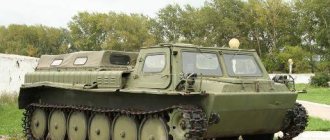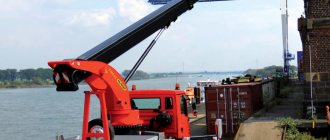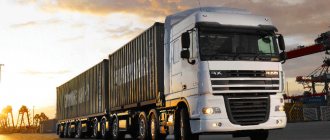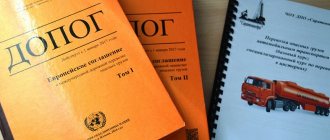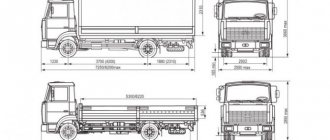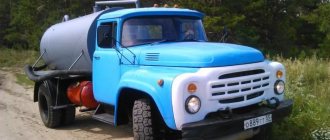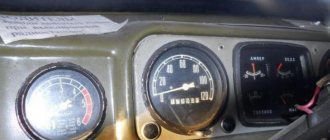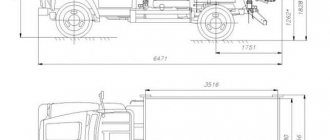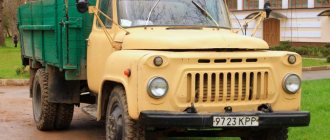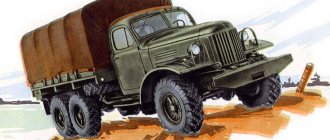The MTLB tracked transporter (designation meaning multi-purpose tractor with light armor) was developed by order of the USSR Armed Forces in the first half of the 60s. last century. The car was produced in factories in several countries; in total, more than 55 thousand copies were manufactured. In addition to army equipment armed with small arms or cannons, there are also civilian modifications of the tractor.
All-terrain vehicle MTLB - when it first appeared
The all-terrain vehicle project was created in the design bureau of the Kharkov Tractor Plant HTZ; it was planned to simultaneously produce the standard MTL model and the armored army analogue MTLB. The company stopped assembling the GTT conveyor (which was transferred to the Rubtsovsky Machine-Building Plant) and in 1964 shipped the first batches of equipment. The civilian version was assembled in a limited batch due to the loading of KhTZ.
Until the collapse of the USSR, almost all assembled armored all-terrain vehicles were supplied to the troops, where they received the original nickname “motolyga”.
A brief comparison of the characteristics of MTLB and GTT:
| Parameter | MTLB | GTT |
| Curb weight, kg | 9700 | 8000 |
| Capacity of the troop compartment, persons. | 11 | 21 |
| Motor power, hp | 240 | 200 |
| Maximum speed on the highway, km/h | 61,5 | 45,5 |
| Speed on water, km/h | until 6 | until 6 |
Where can I buy MTLB
You can buy MTLB from. This equipment can be ordered “from scratch” or from conservation with pre-sale preparation.
Price aspect of MTLB
The price segment directly depends on the attachments and equipment. The cost “from scratch” starts from 2,950,000 rubles. In addition, the price will vary based on the year of manufacture and overall condition.
If purchased from conservation, the price of MTLB will start from 1,390,000 rubles. If you buy it fully equipped and in working order, then the price of MTLB starts from 1,550,000 rubles.
Device and design
The MTLB machine is equipped with a body welded from steel sheets; the joint lines are sealed, which allows the equipment to overcome water obstacles. In the front part there are seats for the driver and the second crew member, the engine is located in the central part of the hull. The gearbox is located in a niche in front of the control compartment and is covered with a noise-insulating casing made of steel sheet. At the rear of the transporter there is a cargo platform; military equipment has a compartment for transporting troops (a rotating turret with weapons stands above the control compartment).
The power unit is shifted to the side relative to the axis of symmetry, the motor is mounted on a subframe through rubber cushions that reduce vibration levels. The exhaust manifold of the left block is used to operate the ejector air purifier.
The engine is equipped with a 3.5 kW alternator, equipped with a rectifier and voltage regulator.
External automotive-type lighting is provided; lighting lamps are used in the driver's cab and cargo compartment.
Machine body
The transporter body is made of steel plates, which are not very dense, so the all-terrain vehicle can only withstand small arms. However, due to this, it was possible to maintain a small weight compared to other cars of this class - 9.7 tons. With such a weight, it was not difficult for the MTLB designers to provide the MTLB with excellent buoyancy. Another advantage of the machine is the low pressure of the tracks on the surface, which increases the maneuverability of the tractor. The body is divided into zones: control, engine, transport and cargo and transmission. Comfortable transportation conditions are provided for everyone on board.
Motor league characteristics
Weight parameters of the MTLB all-terrain vehicle and technical characteristics:
- curb weight of the onboard version - no more than 9940 kg;
- load capacity - up to 2500 kg;
- trailer weight - up to 6500 kg;
- driver's cabin capacity - 2 people;
- number of seats for passengers (instead of cargo) - up to 11;
- specific pressure on the ground - 0.45 kgf/cm²;
- maximum speed - 61.5 km/h;
- traction force (with load on the platform) - up to 8968 kgf.
The turning radius of the all-terrain vehicle depends on what gear the maneuver is in.
Detailed information about turning radii is provided by the manufacturer in the operating instructions; as the gear increases, maneuverability deteriorates. For example, in neutral, the equipment turns around a circle with a radius of 1.25 m, at the highest speed the parameter increases to 38.6 m. The maximum weight of cargo in the body depends on the quality of the soil and on how much the trailer weighs (for example, when the additional cart is fully loaded, the conveyor carries 2000 kg of cargo in the back).
Engine and transmission
The base conveyor uses a YaMZ-238V naturally-aspirated engine with 8 cylinders arranged in a V-shape. The power unit develops a power of 240 hp; in later versions, a supercharging system was introduced, which made it possible to increase the parameter to 310 hp. while reducing fuel consumption. Fuel is poured into 4 separate tanks with a total capacity of 520 liters; a manually operated distribution valve is provided. An electric starter is used to start; in winter, the cooling jacket is heated by an autonomous unit PZD-44L using liquid fuel.
The power system includes an 8-piston high-pressure pump and a manually operated pump for pumping fuel. The air flow passes through an inertial filter and wire cassettes with oiled packing, which allows fine dust to be separated. The design uses a liquid cooling system with forced circulation of antifreeze; the radiator is cooled by a belt-driven fan.
The transmission includes a dry 2-disc clutch with lever control from the pedal and a manual gearbox that provides 6 normal and 5 reduced (used when towing trailers in off-road conditions) forward speeds. On each sidewall there is an onboard planetary gearbox with a friction clutch, which allows you to brake the tracks for turning (the radius depends on the degree of deceleration of the belt). All components are included in the MTLB main transmission device, which provides 2-stream transmission of torque to the drive wheels.
All-terrain vehicle chassis
Since the vehicle was created for military service, the chassis on the MTLB is close to the design of a tracked tank:
- balancers (12 pcs.) are installed on torsion bars, travel limiters and hydraulic shock absorbers are provided on the front and rear arms;
- track rollers (6 pieces per side) are made of aluminum alloy and equipped with an external rubber tire that reduces vibration levels;
- caterpillar tracks are made up of links 350 mm wide, connected by steel fingers (on later machines RMSh belts with a rubber-metal hinge began to be used);
- to tension the track, a crank with a screw is used that moves the rear wheel, which does not have suspension;
- The lantern-type drive sprocket is located at the front, the removable crown has 15 teeth.
Dimensions MTLB
Dimensions and some performance characteristics of the equipment:
- body length - no more than 6509 mm;
- width (with standard open-joint tracks) - up to 2865 mm;
- height - 1890 mm;
- track (between the longitudinal centers of the belts) - 2500 mm;
- base (distance between the axes of the front and rear road wheels) - 3700 mm;
- ground clearance (no load) - 415 mm;
- maximum speed with full load - 45 km/h;
- speed afloat - up to 6 km/h.
Fuel consumption
The consumption per 100 km declared by the plant is in the range of 90-110 kg of fuel, the parameter depends on external conditions, technical condition and degree of loading.
The regulations allow engine oil waste to be 2% of fuel consumption.
Fully filled tanks provide a range of up to 500 km; additional tanks for fuel can be installed in the cargo compartment, which is pumped into the main tanks using a manual or electric pump.
Road handling
To control the MTLB conveyors, an automobile-type pedal block and levers that control the side clutches are used. In front of the mechanic there is a backlit instrument panel, a windshield with a wiper is provided for viewing the area, and a night vision device is provided on army vehicles. Before starting movement, a range is selected, the gearbox lever is moved to the required position, the trajectory is adjusted using levers that allow you to clamp the side brakes with different forces (to obtain a different turning radius).
Motility of MTLB
A tracked all-terrain vehicle equipped with a torsion bar suspension chassis is capable of overcoming obstacles:
- climbability (without trailer) - up to 35°;
- permissible roll angle - up to 25°;
- ford depth with a hard bottom - 1200 mm.
The equipment is designed to overcome water obstacles by swimming, provided that the platform is loaded at a nominal level; when installing a trailer, buoyancy becomes negative.
The all-terrain vehicle can sail at wave heights of up to 500 mm; when wading, the height of the crest should not exceed 150 mm. Before overcoming water obstacles, equipment is prepared; the procedure takes up to 20 minutes.
Maintenance of light multi-purpose tracked transporter-tractor MT-LB (MT-L)
Removing and installing the high pressure fuel pump on the engine Technological map 5. Removing and installing injectors on the engine Technological map 6.
Adjusting the engine control drive Technological map 7.
Adjusting the gearbox control drive Technological map 8. Adjusting the main clutch pedal and the stopping brake pedal Technological map 9. Adjusting the stopping brakes.
7 Technological map 20. Adjustment of the control levers Technological map 2. Adjustment of the free play of the drive box shank of the steering clutch of the rotation mechanism Technological map 22.
Adjusting the steering clutches Technological map 23. Adjusting the gap between the roller of the steering brake lever and the knuckle cavity Technological map 24.
Adjusting the stopping brake drives Technological map 25. Adjusting the track tension Applications:.
All-terrain vehicle modifications
Main modifications of the equipment:
- basic version of MTLB (according to the army classification “Object 6”);
- MTLBV version, intended for operation in the north and equipped with tracks with increased width;
- modifications of MTLBVN and MTLBVNS “Altai”, designed for civilian use;
- MTLTVM1K variant for border troops, adapted for work in high altitude conditions (features a 310-horsepower diesel engine and an improved heater).
At the end of the 90s. The Muromteplovoz enterprise has developed an improved MTLBM chassis, which is being supplied to the army. The basic version is equipped with a turret from the BTR-80 wheeled armored personnel carrier; there is a version with an additional AGS-17 automatic grenade launcher. A model is offered with the installation of anti-tank missiles (additional weapons include a machine gun and a grenade launcher), and a modification is available with an automatic cannon installed in the turret instead of the KPVT machine gun.
Some of the all-terrain vehicles decommissioned from army storage underwent restoration and were sold to civilian consumers. For example, the KTM-10 version is equipped with a body with hinged doors to the driver’s cab, and additional underbody protection is installed. By separate order, a caterpillar with rubber-metal hinges or a special belt with an increased link width, better suited for movement in off-road conditions, can be mounted.
Based on the MTLB, the 1B14 modification was produced, intended for commanders of self-propelled artillery batteries. Inside the closed armored hull there are seats for 6 crew members; the power plant includes a 300-horsepower YaMZ-238N diesel engine. The installation of a PKMB machine gun with 1250 rounds of ammunition is provided; hatches are cut into the body, allowing crew members to fire from personal weapons. The 1B15M version, intended for division commanders, is equipped with a set of improved observation instruments and communications equipment.
After the collapse of the USSR, tracked all-terrain vehicles began to be used by the armed forces of the former republics. For example, Ukraine has developed a self-propelled gun with blocks of unguided S8 projectiles with a caliber of 80 mm. The Russian version of the 6MB, based on the MTLBM chassis, is equipped with a rotating module with a 30 mm automatic cannon. There is a 6MB2 version, additionally armed with an AGS-17 Plamya grenade launcher. Models 6MB3 and 6MB4 are distinguished by the use of GSh-23V and GSh-30K aircraft guns, respectively, coupled with a 12.7 mm Kord machine gun.
All-terrain vehicles SOB (or Sobovka, the abbreviation can stand for “senior battery officer’s transport”) were produced in Bulgaria and Poland (KShM-81 “Dolphin” and WDSz, respectively). In the 90s On the basis of MTLB, Polish designers created a modernized Opal-I vehicle, equipped with a SW0680/167/1 diesel engine and an original turret with a heavy machine gun. There was an extended version of Opal-II (analogous to MTLB), equipped with a SW-680T diesel engine with a power of 300 hp. More than 10 modifications have been created based on the Opal chassis.
Based on the body and chassis of the all-terrain vehicle, the MTLBu model was created, characterized by the introduction of an additional roller.
The Gvozdika self-propelled howitzer and the Deva mortar system are built on the basis of an extended chassis. In total, on the basis of MTLB, designers of the USSR, Russia and Eastern European countries created more than 100 modifications, while some versions were released in single copies, and some were built in large production batches. At the same time, equipment is being replaced by new all-terrain vehicles (for example, Vityaz), which have an increased carrying capacity.
MTLB with CMU
The multifunctional all-terrain vehicle MTLB is designed for towing trailers with a total weight of up to 6.5 tons, as well as for mounting diverse installations, transporting heavy cargo and people, and providing other transport tasks. It was actively used in the USSR army as a tractor for artillery guns, as well as for transporting crew.
Due to its versatility, the MTLB tracked all-terrain vehicle has also found its application among government services. It gained particular popularity among the population living in the far north and in inaccessible surroundings. Excellent maneuverability in snowy, sandy and swampy areas.
Features of operation
Before starting winter operation, it is necessary to drain all freezing liquids and fill the radiator with antifreeze. Check the operation of the pre-heater, unscrew the bolt securing the drain tube and drain the condensate. When storing the conveyor in open areas at air temperatures below -15°C, it is recommended to remove the batteries at night. To protect the platform from snow, use a standard tarpaulin cover.
When operating an all-terrain vehicle in desert and steppe conditions, it is necessary to regularly check the electrolyte level in the batteries and top up with distilled water. After 20-30 hours of diesel operation (according to the meter), the filter should be washed and accumulated dirt should be removed from the cyclone hopper. If you plan to repair units that involve disassembling components, then the work should be performed under a protective canopy that prevents sand and dust from getting on the mating surfaces.
In mountainous conditions, it is necessary to fill the cooling system with antifreeze; if water is used in the circuit, it is drained overnight. If traces of scale are found in the radiator, the unit should be washed with special reagents that dissolve the deposit. The electrolyte level in batteries must be checked after 3-4 days of operation; distilled water must be used to top up. After overcoming contaminated sections of the road, the radiators should be cleaned of foreign deposits; water should not enter the final drive housings of the all-terrain vehicle.
Frequent breakdowns and repairs
Common defects and methods for restoring functionality:
- Increased engine oil consumption with a simultaneous drop in power and the appearance of smoky exhaust indicate wear of the diesel piston group. Repair consists of overhauling the unit and replacing failed parts.
- During operation, due to improper tension, the track gradually breaks down, the holes for the pins break and take on the shape of an ellipse. The parts cannot be restored; a new track must be installed.
- Due to untimely maintenance, the torsion bar guide element is destroyed and lubricant begins to leak through the cracks. To restore functionality, it is necessary to cut out the worn guide and weld a new unit, since it is impossible to fix the bushing in the old socket.
- The rubber rings of the rollers are worn out and damaged by the sharp edges of stones, the sidewalls of the aluminum disk are worn away by the teeth of a track that has incorrect tension. Shock-absorbing rings can be changed provided that the sides on the wheels are preserved; if the elements are worn out, then the support wheel assembly must be replaced.
- If the filter unit is not cleaned in a timely manner, it begins to let in fine dust, which gets into the cylinders and the oil pan, causing premature wear of the rubbing parts. Due to the increase in gaps, power drops and starting deteriorates; the engine needs major repairs.
- When driving through the forest, the body of the all-terrain vehicle is exposed to branches, which remove the paint and damage the lighting elements. The metal begins to rust, but through holes do not appear due to the large thickness of the parts (7-14 mm). It is recommended to periodically refresh the paintwork and promptly replace broken glass in the headlights, since water destroys the reflectors.
Do you need rights?
To drive tracked vehicles with an engine power of more than 25.7 kW, you need a category E tractor driver's license. Information about the type of license is present in regulatory documents and acts (for example, in the Decree of the Government of the Russian Federation No. 796 of July 12, 1997, similar information is given and in Order No. 807, issued by the Ministry of Agriculture of the Russian Federation on November 29, 1999). Since the all-terrain vehicle is large in size and weight, an experienced driver must operate the vehicle.
Use in military units
The all-terrain vehicles delivered to army units took part in combat operations for the first time during the war in Afghanistan. After the collapse of the USSR, transporters went to the former Soviet republics and were used in local conflicts. The vehicles were intended to deliver cargo, ammunition for mortars or artillery, as well as evacuate the wounded. The hull armor withstood bullets fired from Kalashnikov assault rifles at any distance. The machine gun installed in the turret was used to protect the crew of the all-terrain vehicle or the crew of the towed gun.
All-terrain vehicles were not part of the staff of motorized rifle battalions (MSB), but some were used to transport personnel. During the Afghan War, some of the vehicles underwent field modernization. For example, the towed mortar "Vasilek" was installed in a cargo platform, which contradicted the requirements of the manual for combat use, but increased the maneuverability of the firing point. The transportable ammunition was located inside the hull and was also attached to the outside of the sheets along with additional crew equipment.
Buy MTLBU in Russia – prices for a multifunctional tractor, characteristics
Do you need high-quality and reliable equipment to conquer off-road terrain?
The best option is to buy MTLBU. The military name for this vehicle is “Object 10”. Civilian - light armored multi-purpose tractor with a universal body. This technique was developed in the 60s of the last century on the basis of military MTLB, but received a completely peaceful purpose. Its universal body made it possible to deploy laboratories and workshops inside the transporter, transport groups of people and cargo over long distances in conditions of complete absence of roads, and also engage in oil and gas and geological fields. Although this equipment was considered civilian, it was not available for free sale, so to buy MTLBU on the market. But if you set a goal, then everything can be solved.
Advantages and disadvantages
Advantages of the technique:
- availability of spare parts for the engine;
- the design of the motor allows for major repairs;
- simple design of the chassis and transmission;
- a lower row is provided in the gearbox;
- In addition to standard tracks, belts with increased link width can be installed.
Disadvantages of an all-terrain vehicle:
- weak armament of army modifications;
- thin bottom armor is destroyed when hitting a mine;
- fuel leakage through connecting lines.
The disadvantage of the all-terrain vehicle is the cramped cabin, which has uncomfortable seats and no air conditioning. The engine located behind the driver and passenger seats heats up the cabin, and there is no sound insulation on the rear wall. A civilian diesel engine is used, which responds slowly to pressure on the gas pedal; when quickly switching to a lower speed in marshy areas, the engine does not have time to gain speed, which leads to getting stuck.
